Before the ZBD-04, was the ZBD-97 (Factory designation WZ502), a fully tracked infantry fighting vehicle (IFV) developed for the Chinese People’s Liberation Army (PLA). The ZBD-97 entered service in 1999 to early 2000s while the ZBD-04 entered service in 2006. Both are designed to serve independently of, or in coordination with main battle tanks. They carries a fully equipped infantry squad whole covering them with heavy fire support, while keeping amphibious capabilities. The ZBD-04 (ZBD-97 main production run) is today deployed with the Guangzhou and Nanjing military regions. It was declined into multiple variants, including an Ambutank, Engineering Vehicle and Anit-tank missile vehicle as well as an ARV and evolved into the improved ZBD-04A.
Standard sources states the project origin was the 1997 Chinese government licence rights purchase of the Russian BMP-3 fire control system (not the whole vehicle), complete with its low-pressure rifled 100mm gun, and coaxial 30mm 2A72 automatic cannon plus the through-tune ATGM technology associated. The 2A72 was further developed as the 2A42, and the new prototype was dubbed ZBD 97 or Type 97 given the year of this purchase happened. It was the first denomination, maintained until a suitable production vehicle was ready for mass production, so from 1997 to 2004 according to most sources. 2004 was the year of acceptance.
First unveiled at the military parade in Beijing for the 60th anniversary of the People's Republic of China, on 01 October 2009, the new vehicle saw by western experts bore the name ZBD-04. The new infantry fighting vehicle was indeed presented as replacement for the ageing Type 86 IFV, and fast enough to operate with the 3rd gen Type 96 and Type 99 main battle tanks.
For observation and fire-control, three periscopes are provided to the driver’s hatch mount. The central one as usual can be swapped for an image intensifying periscope for night-vision drive. Two headlights are fitted on the front armour of the hull, including blackout lights. The main gunner sight combines an image-intensified day or night-sight and a standard day sight. The commander only had a day sight which is combined with an image-intensified night-sight. The fire-control system makes use of a ballistics computer and communicates settings automatically to the electro-mechanical gun stabiliser in real time. For better accuracy, the system is also provided with a laser range finder.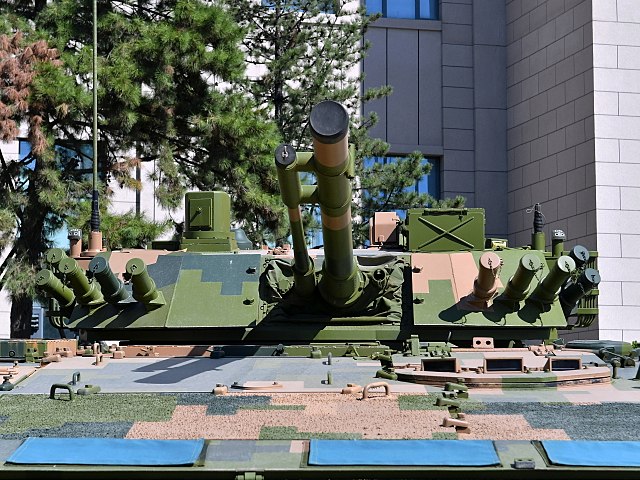
Turret front detail, ZBD-04A: The turret shows side by side the 30 mm coaxial automatic cannon, the 100 mm rifled gun, 7.62mm coaxial LMG, Commander's Independent Thermal Viewer (CITV), gunner thermal sight, emergency daylight sight, laser warning receivers on top of the turret.
The main armament located in the turret center is a semi-automatic combined low-pressure 100mm gun/missile launcher. It is stabilised in two plans, and the rifled tube is capable of accepting both HE-FRAG rounds and 3UBK10 anti-tank guided missiles. When firing the HE-FRAG round the rate of fire is ten a minute. Its best range is around 4,000m, probably closer to 3,000 to be effective. The vehicle carries 30 HE-FRAG rounds.
The 3UBK10 ATGM is derived from the Soviet-era AT-10 Stabber. This missile is said capable of penetrating up to 600 mm of RHA armor behind ERA protection. Thus it is able to defeat most current main battle tanks. It is also claimed with a 80% first hit capability. Universal, and could be also be used against ground fixed installation and low-flying helicopters with the same useful range of 4,000m. Designers made possible to store eight missiles inside the turret. Since it is loaded via the cannon there is no need for the personal to expose itself to enemy fire. There is even a sub-variant of the ZBD-04 that can carry four extra HJ-8 wire-guided anti-tank missiles on both sides of the turret. This would made for a total of 8 3UBK1 and four HJ-8, all said capable of destroying any Russian or NATO 3rd gen MBT.
The second piece of this system is a 30mm coaxial automatic cannon usable as secondary weapon, about the same potency as for the BMP-2. It fires and fire armour-piercing (AP) or an HE-FRAG round with a rate of fire of 300 a minute and a useful range of half the main gun at 2,000m (1.5 km for best accuracy). The vehicles carries 500 rounds of 30 mm, likely HE, and in this stock can be added the armor-piercing discarding sabot (APDS) or the armor-piercing fin-stabilized discarding sabot (APFSDS).
The third piece of the system is the 7.62mm coaxial machine gun used against infantry and firing tracers. The ammo load is circa 2000 rounds.
The fourth element is the dismounted one: The seven infantry which could in addition to their personal weapons, carry a mortar, a mobile ATGM, or a MANPADS to complete the AA protection of the entire system.
The second passive protection layer is the collective NBC protection system (Nuclear Biological and Chemical) resting on the air filter at the back-right of the turret. It is completed by an overpressure system and climatization. There is also a spall liner to protect the interior from splinters.
There is a basic protection against fire, in the shape of an equivalent of the Halon protection system, combining a detector and a sprinkler working automatically, one in the engine compartment, one in the main combat space. The level of protection for the ATGMs or the HE-FRAG rounds is unknown. Thus, the "cooking" of these stays a possibility.
The active protection layers is centered around two systems: A classic three-barrel smoke grenade launcher fitted on each side of the forward modular turret bustle, and by default of the ARENA-E active protection system fitted on the latest BMP-3, the ZBD-97 is likely to receive a laser warning and countermeasures system.
This power unit thus enables a top speed 65 km/h, a swimming speed of 20km/h. This is better compared to the 72/10 km/h figures of the BMP-3. It reflects the emphasis put on the amphibious capability and efforts made to create AFVs that could be as fast as possible at sea to reduce their exposition to enemy fire during their corssing to the beach. The vehicle has a maximum range of 500 km. The BF8M1015CP diesel which estimated outpout can go up to 590 hp is mated to a 4-speed manual gearbox.
The drivetrain features six standard road wheels (instead of seven on the BMP-3) with front drive sprockets, rear idlers and three track return support rollers. The unevenly spaced road wheels are all rubberized. For suspension, only the 1st, 2nd and 6th road wheels are given hydraulic shock absorbers in addition to the torsion bars used by all axles. The tracks driven by the froward sprocket and tensioned by the idlers back, are of the double-pin, double-sided, double hanging type. To protect the tracks, notably on hard groud and roads, the links are fitted with removable rubber pads, also helping to improve ride comfort and noise.
Testing figures are only prospective, evaluated by experts: The ZBD-97 would be capable of negociating a Gradient of 60%, stay stable on a 40% side slope, climb a vertical step circa 0.7 m high and gap a trench of 1.8 m.
For amphibious operations, the ZBD-97/04 vehicle is fitted with two large water jets at the rear which considerably helped a fast swim. It is somewhat similar to the BMP-3 own water jets (single-stage, axial, auger-type), but the Chinese managed to obtain twice the speed. In complement to swim without preparation, the hydraulically operated trim vane is erected forward and the bilge pumps activated. There is enough reserve of buoyancy inside to allow the vehicle a relatively comfortable margin above water. This is helped by the shape of the exhaust and a water intrusion clapet system. The vehicle is tall enough to have a margin of seaworthiness as shown here enabling crossing by a sea state 2-3. This is much better than the BMP-3 overall.
As for air-transport, the vehicle could be transported in the Xi'an Y-20, and could be paradropped, using a palette with multiple parachutes and cushion platform.
Thus, there could be an additional confusion between the chassis produced for various specialist uses and main IFV production on top of the naming. So far the ZBD-04 equipped by the amphibious mechanized divisions in the South Military Region of China, hence the strong impetus on emphibious performances. It would certainly be used in the upcoming invasion of Taiwan alongside it's faster evolution unlike the more modern ZBD-04A, way too heavy and reserved for the PLA only.
Most sources today are stating 2,950+ total, all variants included, as of 2021 (so probably more than 3,500 as of today). 400 units ZBD-04, 450 ZBD-04 HJ-8 Carrier (tank hunter variant), and 1,900 units ZBD-04A (some sources ZBD-08) plus 200 of the upgraded ZBD-04A HJ-10 Carrier and tank hunter. Excluded from this total are the ambulance, command, ARV, self-propelled mortar, and reconnaissance variants.
The engine also receives an upgrade due to the heavier load, enabling the vehicle to reach a top 75km/h, so probably with an output of 650 to 700 hp. Heavier, it is still able ford rivers and lakes, but amphibious capabilities are said degraded beyond any floating capability. It seems this main point was adressed by the ZBD-08. Inside the turret there is a new fire control system, complete with an upgraded ballistic computer enabling firing on the move in any conditions of visbility, day or night, better electro-mechanical gun stabiliser, and updated laser rangefinder. It seems also the active protection is enhanced by the addition of two twin smoke dischargers on the side panels in addition of the two triple at the front, and BAR armor at the turret's rear acting also as external storage. The vehicle has been produced to a less extent compared to the ZBD-04 and only used by the Army, as only the regular 04 is light enough for the Chinese Marines. The 04A will be the object of a second dedicated post.

3D rendition

ZBD-04 Vehicle in parade

Same, with the army digital camouflage
From ZBD-97 to ZBD-04: The long road to production
If early development whereabouts of the ZBD-97 are unknown, the vehicle was clearly designed in the early 1990s as a replacement for the BMP-1 Chinese clone, called the Type 86 IFV. The BMP-1 was a 1960s vehicle and clearly obsolete, leading to a limited production run of circa 1500 vehicles, but in the early 1990s the concept was already dated. The design of the Russian BMP-3 was seriously looked at for its heavy armament, a coupled 100mm main gun and 30 mm to deal with helicopters and a light machine gun. The design team obviously wanted to turn out a similar design, and improve on it.Standard sources states the project origin was the 1997 Chinese government licence rights purchase of the Russian BMP-3 fire control system (not the whole vehicle), complete with its low-pressure rifled 100mm gun, and coaxial 30mm 2A72 automatic cannon plus the through-tune ATGM technology associated. The 2A72 was further developed as the 2A42, and the new prototype was dubbed ZBD 97 or Type 97 given the year of this purchase happened. It was the first denomination, maintained until a suitable production vehicle was ready for mass production, so from 1997 to 2004 according to most sources. 2004 was the year of acceptance.
First unveiled at the military parade in Beijing for the 60th anniversary of the People's Republic of China, on 01 October 2009, the new vehicle saw by western experts bore the name ZBD-04. The new infantry fighting vehicle was indeed presented as replacement for the ageing Type 86 IFV, and fast enough to operate with the 3rd gen Type 96 and Type 99 main battle tanks.
Design
The ZBD-97 has a typical chassis with a well sloped split nose with a two-man turret, both custom-made reminiscent of the BMP-3 in general outlook. The armament was different however (see later). The conventional layout mixed a RHA welded steel hull with modular protection. The core crew of three (commander, driver and gunner) was complemented by a dismounted crew of seven fully equipped soldiers (like the BMP-3) installed in the rear troop compartment. The powerplant is located on the forward-right side. The rear compartment enables easy access and exit through a single back door and in addition two large roof hatches. There are three observation points: Two either side of the hull, one in the exit door doubling as postol ports to fire on the move.For observation and fire-control, three periscopes are provided to the driver’s hatch mount. The central one as usual can be swapped for an image intensifying periscope for night-vision drive. Two headlights are fitted on the front armour of the hull, including blackout lights. The main gunner sight combines an image-intensified day or night-sight and a standard day sight. The commander only had a day sight which is combined with an image-intensified night-sight. The fire-control system makes use of a ballistics computer and communicates settings automatically to the electro-mechanical gun stabiliser in real time. For better accuracy, the system is also provided with a laser range finder.
Armament

Turret front detail, ZBD-04A: The turret shows side by side the 30 mm coaxial automatic cannon, the 100 mm rifled gun, 7.62mm coaxial LMG, Commander's Independent Thermal Viewer (CITV), gunner thermal sight, emergency daylight sight, laser warning receivers on top of the turret.
The main armament located in the turret center is a semi-automatic combined low-pressure 100mm gun/missile launcher. It is stabilised in two plans, and the rifled tube is capable of accepting both HE-FRAG rounds and 3UBK10 anti-tank guided missiles. When firing the HE-FRAG round the rate of fire is ten a minute. Its best range is around 4,000m, probably closer to 3,000 to be effective. The vehicle carries 30 HE-FRAG rounds.
The 3UBK10 ATGM is derived from the Soviet-era AT-10 Stabber. This missile is said capable of penetrating up to 600 mm of RHA armor behind ERA protection. Thus it is able to defeat most current main battle tanks. It is also claimed with a 80% first hit capability. Universal, and could be also be used against ground fixed installation and low-flying helicopters with the same useful range of 4,000m. Designers made possible to store eight missiles inside the turret. Since it is loaded via the cannon there is no need for the personal to expose itself to enemy fire. There is even a sub-variant of the ZBD-04 that can carry four extra HJ-8 wire-guided anti-tank missiles on both sides of the turret. This would made for a total of 8 3UBK1 and four HJ-8, all said capable of destroying any Russian or NATO 3rd gen MBT.
The second piece of this system is a 30mm coaxial automatic cannon usable as secondary weapon, about the same potency as for the BMP-2. It fires and fire armour-piercing (AP) or an HE-FRAG round with a rate of fire of 300 a minute and a useful range of half the main gun at 2,000m (1.5 km for best accuracy). The vehicles carries 500 rounds of 30 mm, likely HE, and in this stock can be added the armor-piercing discarding sabot (APDS) or the armor-piercing fin-stabilized discarding sabot (APFSDS).
The third piece of the system is the 7.62mm coaxial machine gun used against infantry and firing tracers. The ammo load is circa 2000 rounds.
The fourth element is the dismounted one: The seven infantry which could in addition to their personal weapons, carry a mortar, a mobile ATGM, or a MANPADS to complete the AA protection of the entire system.
Protection
The basic, passive protection is offered by a high grade reinforced steel, with welded steel armour plating estimated or around 8 to 30 mm (1.2 in) to protect against small arms and shell splinters. Due to the highly slope nose, the 30 mm are sufficient to defeat 20 to 30 mm autocannon fire. The sides offer resistance only against 8mm rounds and shrapnel. The evolved 04A is however proof against 14.5mm machine gun rounds. There is however no protection against ATGMs or even RPGs at least on the sides.The second passive protection layer is the collective NBC protection system (Nuclear Biological and Chemical) resting on the air filter at the back-right of the turret. It is completed by an overpressure system and climatization. There is also a spall liner to protect the interior from splinters.
There is a basic protection against fire, in the shape of an equivalent of the Halon protection system, combining a detector and a sprinkler working automatically, one in the engine compartment, one in the main combat space. The level of protection for the ATGMs or the HE-FRAG rounds is unknown. Thus, the "cooking" of these stays a possibility.
The active protection layers is centered around two systems: A classic three-barrel smoke grenade launcher fitted on each side of the forward modular turret bustle, and by default of the ARENA-E active protection system fitted on the latest BMP-3, the ZBD-97 is likely to receive a laser warning and countermeasures system.
Propulsion & Mobility
The ZBD-97 runs with a liquid-cooled diesel engine. This is a 8V150 water-cooled four cylinder engine, shared with the ZTZ-99 main battle tank, capable of developing 400 kilowatts. Located in the front left compartment with exhaust grilles and access hatches on top of the nose. There is a massive, rectangular radiator on the left above the power capsule cover, an it can be easily disconnected from the tranmission for easy removal and replacement on the field. The water-cooled diesel is multifuel could be the BF8M1015CP/MV-type diesel sharing most parts with similar power units, making it cheaper and simpler to maintain. The power transmission comprises an extra rear shaft to activate the propellers for the jet propulsion at the rear, and this transmission system is not comparable to the BMP-3's own, procuring a much greater torque (and better speed overall).This power unit thus enables a top speed 65 km/h, a swimming speed of 20km/h. This is better compared to the 72/10 km/h figures of the BMP-3. It reflects the emphasis put on the amphibious capability and efforts made to create AFVs that could be as fast as possible at sea to reduce their exposition to enemy fire during their corssing to the beach. The vehicle has a maximum range of 500 km. The BF8M1015CP diesel which estimated outpout can go up to 590 hp is mated to a 4-speed manual gearbox.
The drivetrain features six standard road wheels (instead of seven on the BMP-3) with front drive sprockets, rear idlers and three track return support rollers. The unevenly spaced road wheels are all rubberized. For suspension, only the 1st, 2nd and 6th road wheels are given hydraulic shock absorbers in addition to the torsion bars used by all axles. The tracks driven by the froward sprocket and tensioned by the idlers back, are of the double-pin, double-sided, double hanging type. To protect the tracks, notably on hard groud and roads, the links are fitted with removable rubber pads, also helping to improve ride comfort and noise.
Testing figures are only prospective, evaluated by experts: The ZBD-97 would be capable of negociating a Gradient of 60%, stay stable on a 40% side slope, climb a vertical step circa 0.7 m high and gap a trench of 1.8 m.
For amphibious operations, the ZBD-97/04 vehicle is fitted with two large water jets at the rear which considerably helped a fast swim. It is somewhat similar to the BMP-3 own water jets (single-stage, axial, auger-type), but the Chinese managed to obtain twice the speed. In complement to swim without preparation, the hydraulically operated trim vane is erected forward and the bilge pumps activated. There is enough reserve of buoyancy inside to allow the vehicle a relatively comfortable margin above water. This is helped by the shape of the exhaust and a water intrusion clapet system. The vehicle is tall enough to have a margin of seaworthiness as shown here enabling crossing by a sea state 2-3. This is much better than the BMP-3 overall.
As for air-transport, the vehicle could be transported in the Xi'an Y-20, and could be paradropped, using a palette with multiple parachutes and cushion platform.
Production and Variants
So far, absolute production records (for the ZBD-97 compared to the 04) are a mystery. Some sources states around 500 vehicles, other medias points to 650 units, but with some confusion between the ZBD-97 and 04, which production really started in 2006.Thus, there could be an additional confusion between the chassis produced for various specialist uses and main IFV production on top of the naming. So far the ZBD-04 equipped by the amphibious mechanized divisions in the South Military Region of China, hence the strong impetus on emphibious performances. It would certainly be used in the upcoming invasion of Taiwan alongside it's faster evolution unlike the more modern ZBD-04A, way too heavy and reserved for the PLA only.
Most sources today are stating 2,950+ total, all variants included, as of 2021 (so probably more than 3,500 as of today). 400 units ZBD-04, 450 ZBD-04 HJ-8 Carrier (tank hunter variant), and 1,900 units ZBD-04A (some sources ZBD-08) plus 200 of the upgraded ZBD-04A HJ-10 Carrier and tank hunter. Excluded from this total are the ambulance, command, ARV, self-propelled mortar, and reconnaissance variants.
ZBD-97
The base vehicle tested in the late-1990s, eary 2000s only entering service in limited numbers to test the concept until the final adoption.ZBD-04
The production name of the vehicle, entering service in 2006, revealed in beijing in 2009, and apparently without added protection as seen on the next 04A and with a limited production (400 for some sources). This chassis was used as a base for the number of variant as seen below:ZBD-04 ARV
Armored recovery version (see the ref image below) fitted with a crane mounted to the left side of the top of the aft raised section of the hull, while the commander's hatch and driver's raised hatch has a single KPT-style heavy machine gun for self defence. There are strapping on the hull's side to hoist additional equipments. The crew is likely of three, with a driver, commander and main operator.ZBD-04 HJ-8
Based on the original ZBD-04 with four additional HJ-8 anti-tank missiles mounted on the turret. The chassis is the same as the regular production 04 vehicle.ZBD-04A (WZ502G)
The ZBD-04A is an advanced version which focused of better passie protection through addon armour panels, bolt-on the hull sides. They are composite and provides enough resistance against rocket-propelled grenades (RPG) and anti-tank guided missiles (ATGM). The forward nose section recives also additional panels to better resist 30mm autocannon fire and the sides 14.7 mm heavy machine gun. there is also an addon side skirt composed of four identical panels, one smaller at the rear, plus extreme front and rear panels, destine to deal with ATGMs and RPGs.The engine also receives an upgrade due to the heavier load, enabling the vehicle to reach a top 75km/h, so probably with an output of 650 to 700 hp. Heavier, it is still able ford rivers and lakes, but amphibious capabilities are said degraded beyond any floating capability. It seems this main point was adressed by the ZBD-08. Inside the turret there is a new fire control system, complete with an upgraded ballistic computer enabling firing on the move in any conditions of visbility, day or night, better electro-mechanical gun stabiliser, and updated laser rangefinder. It seems also the active protection is enhanced by the addition of two twin smoke dischargers on the side panels in addition of the two triple at the front, and BAR armor at the turret's rear acting also as external storage. The vehicle has been produced to a less extent compared to the ZBD-04 and only used by the Army, as only the regular 04 is light enough for the Chinese Marines. The 04A will be the object of a second dedicated post.
ZBD-04A AT
AFT-10 Anti-Tank Missile Carrier, based on the 04A chassis. Mobile launching platform for the AFT-10 (HJ-10) anti-tank missile. The latter is a derivative of the HJ-10 missile, locvated in an octupàle acanister with elevation and 360° traverse. This is the same missile as gun-fired by the ZBD-04A. Sensors include a thermal camera, TV camera, laser range finder, millimeter-wave radar (front-right corner) for all-weather operation.ZBD-04A Command Vehicle
Modified from the original ZBD-04A, featuring a crew cabin with a higher ceiling.ZBD-04A Combat Reconnaissance Vehicle
Equipped with radars and electric-optic sights for battlefield surveillance, the chassis of the Combat Reconnaissance Vehicle is modified from standard ZBD-04A. The recon equipment is mounted on a retractable mast.ZBD-04A Armored Recovery Vehicle
Same as above, but on the 04A chassis, again with a crane for emergency vehicle service.PLZ-07
122 mm self-propelled howitzer based on the ZBD-04 chassis. It is also known as the PLZ-05A or Type 05A, a modified clone of the Russian 2S31 Vena using a larger turret with a gun-mortar system, in production tp support mechanized troops. In 1997 China planned to acquire 100 2S23 Nona-SVK but it was never agreed upon and instead China bought three 2S9 Nona-S mortar systems from Ukraine in 2000, reverse engineered and presented as the PLL-05 in 2005 based on the Type 92 6x6 APC chassis. In 2013 the tracked based variant on the 04A chassis was entering service. Production records are unknown.VN-11
The VN-11 infantry fighting vehicle is the export variant of the ZBD-04. It has a maximum floating speed of 13 km/h, the front is more raked, but had more advanced hydrodynamic performance. It is carrying a crew of 2+7 weighting 21.5 tons, for 7.52 meters long, 3.3 meters wide, 2.53 meters high and capable of crossing 400 km. So far it has been marketed but not exported.VN-11a
Same, but based on the 04A chassis and with the same basic, but add-on armour, side skirts, improved turret. No known customer yet.VN-12
The VN-12 infantry fighting vehicle presented ast Zhuhai AirShow China in 2014 by NORINCO as an improved export version of the ZBD-04A, fitted with a modified turret and bolt-on applique armor, STANAG 4569 level 4/5 forward and level 3/4 all-round. No export customer has been signalled yet. It is also proposed and marketed with the smaller Type 86G IFV turret.ZBD-08
There are conflicting informations about the denomination, which is valid also for the 04A. Some sources states the 04A is a preserie or transitional vehicle, while the 08 is the main mass production vehicle. For some sources and sites, this is the same as the 04A. On army-guide the vehicle is also presented as the successor of the ZBD-04. Factory designation WZ502G is the same as for the 04 so a rule we will retain here the 04A designation.
3D rendition

ZBD-04 Vehicle in parade

Same, with the army digital camouflage
ZBD 97 specifications | |
| Dimensions | 8 x3 x2.1 m (26.4 x9.8 x6.8 ft) |
| Total weight, battle ready | 21 tons (42,000 Ibs) |
| Crew | 3+7 (driver, gunner, cdr, 7 troops) |
| Propulsion | DEUTZ BF6M1015 diesel 390hp mech transm |
| Suspension | 8x8 independent coil springs/SD |
| Speed (road/water) | 100/8 km/h (60 mph) |
| Range | 800 km (500 mi) |
| Armament | IFV: 30mm autocannon, coaxial 7.62 mm LMG, 2 ATGM |
| Armor | Protection against 7.62 to 12.7mm |
| Total production | Current |
Gallery
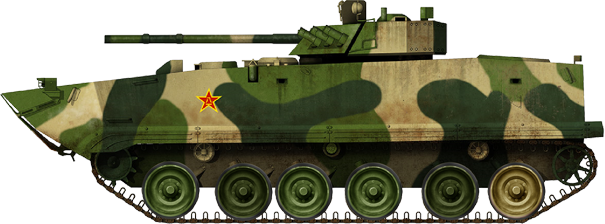
ZBD-97 (preserie) Infantry Fighting Vehicle in its original wavy tri-tone pattern in 1999-2000.
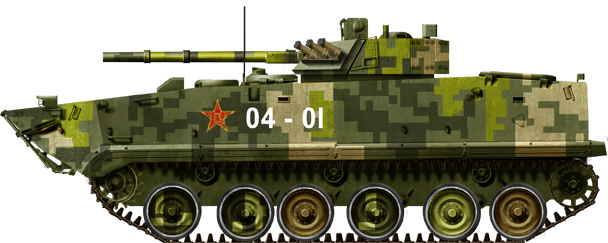
ZBD-04 with a digital camouflage in parade as of 2009.
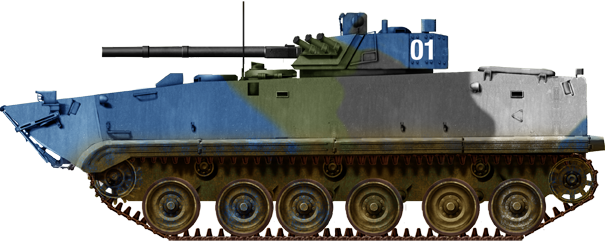
ZBD-04 with the PLAN (Chinese Navy) in the 2000s.
More to come: Specialized ZBD-04 ARV, ZBD-04 HJ-8 and VN-11 export variant (and dedicated articles).
Gallery
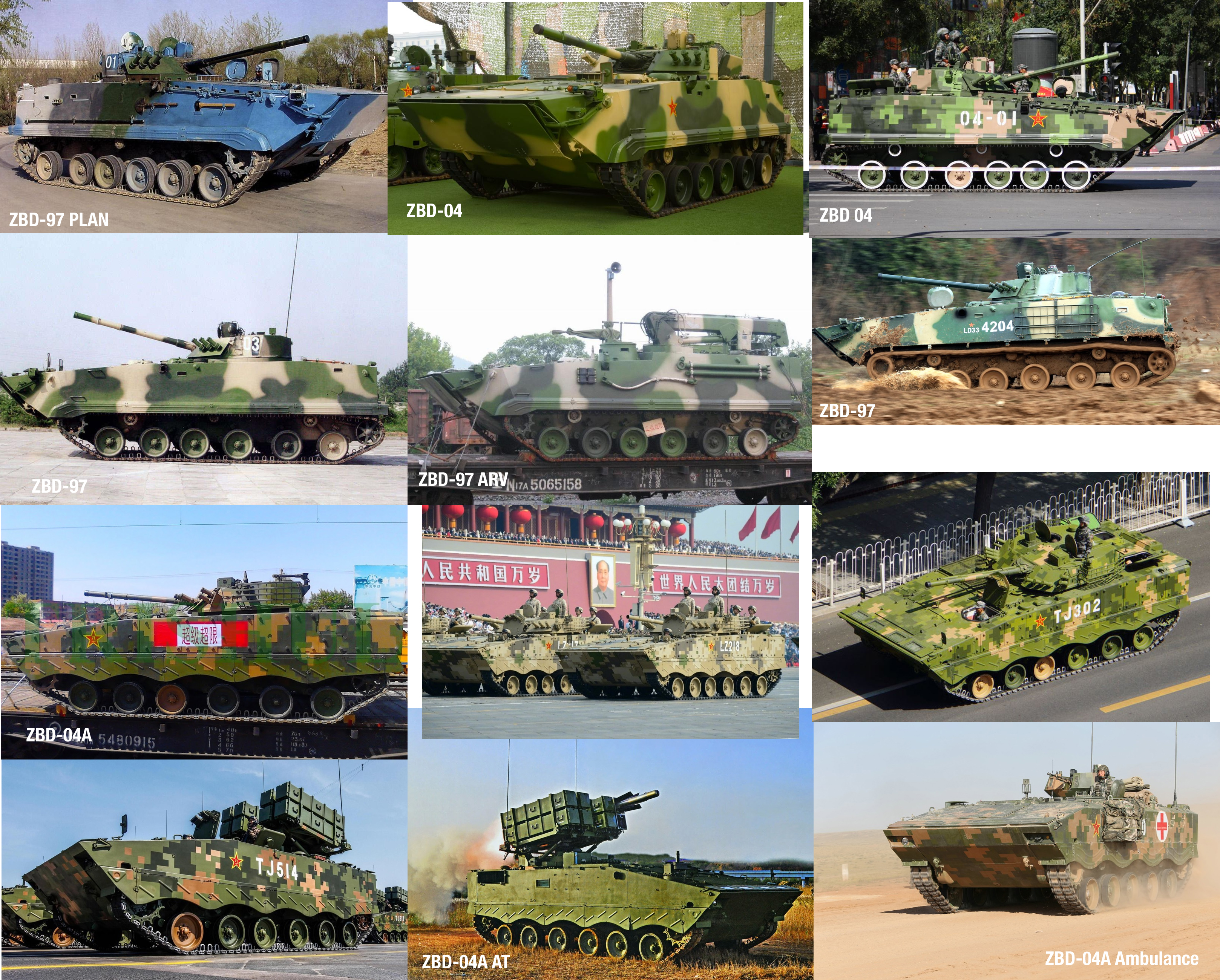
Various references of variants
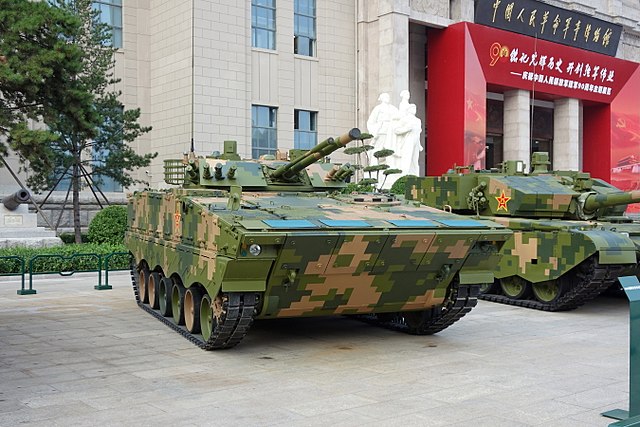
ZBD-04A
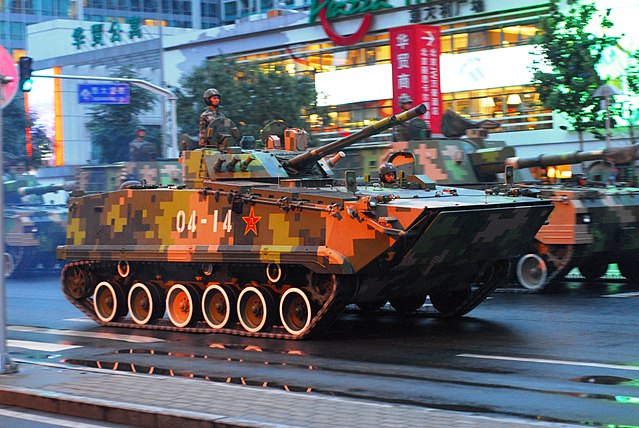
ZBD-04 in parade anniversary
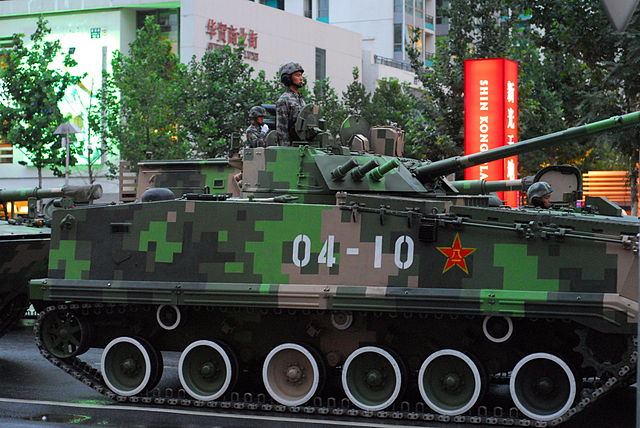
ZBD-04 in parade, Beijing
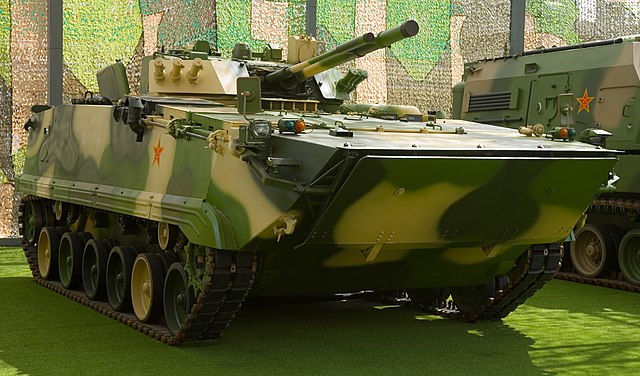
Front right view, ZBD-04
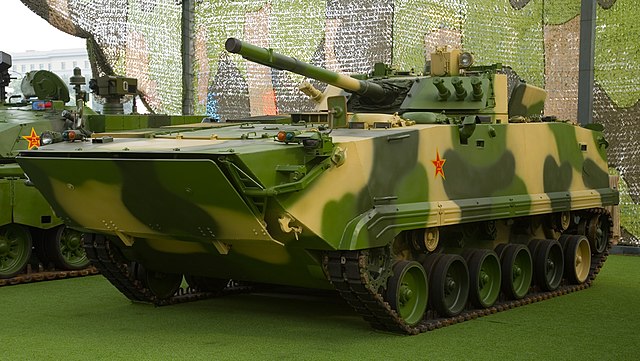
Left view, ZBD-04
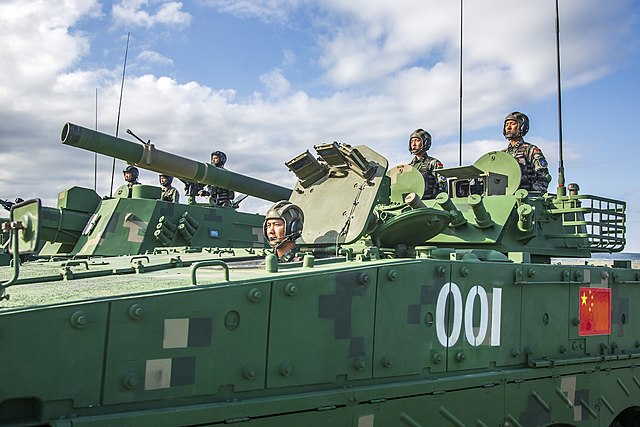
Type 04A in a meace keeping mission 2018
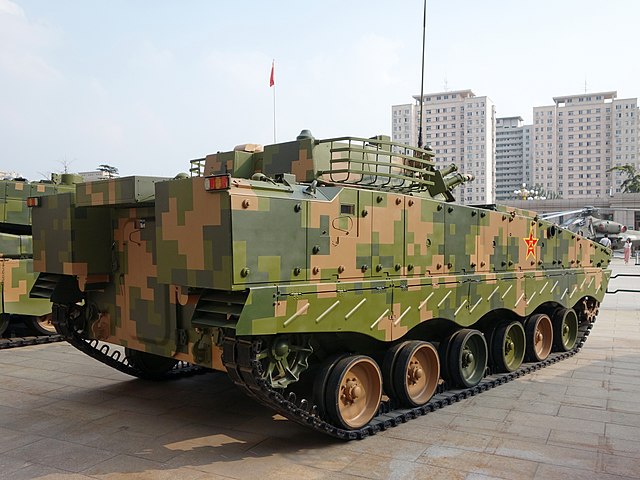
Rear, ZBD-04A
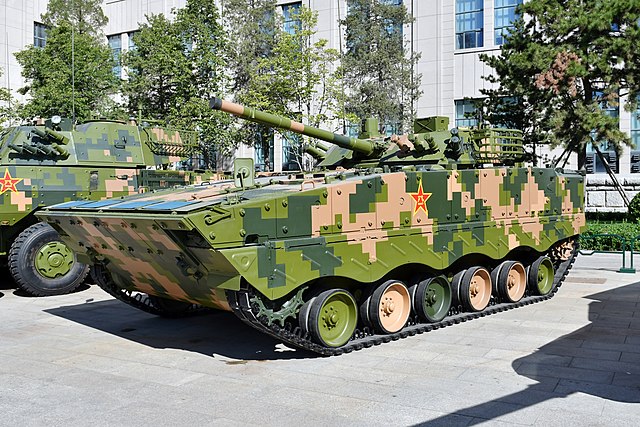
Front left view, 04A
Links/Src
links
On sinodefenceforum.comVN-12 on tankandafvnews.com/
wz502g on en.topwar.ru
war-book.ru
military-wiki.com
3D model on turbosquid.com/
On weaponsystems.net/
militaryfactory.com
army-technology.com
wikipedia.org
military-today.com
.armyrecognition.com
ZBD-97 on army-guide.com
ZBD-04 and VN-11 on army-guide.com
globalsecurity.org/
strategic-bureau.com
About the VN-11
The ZBD-08 on military-today.com
Video

Modern Tanks
Modern MBTs posters

Denel Bagder (2018)

Type 16 MCV (2016)

Gepard 1A2 last rounds 2011

SANDF

Russian AFVs

Main Battle Tanks
